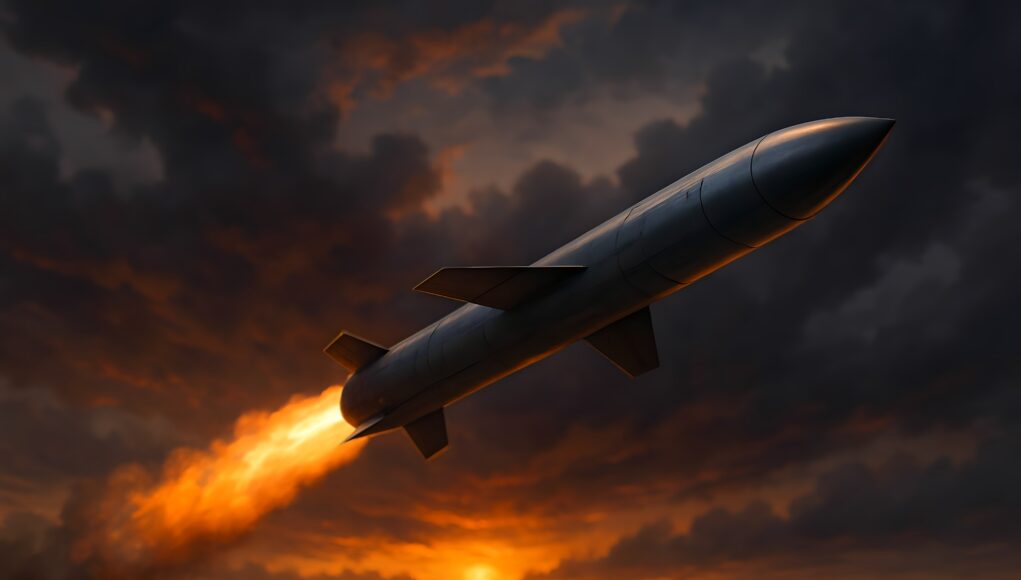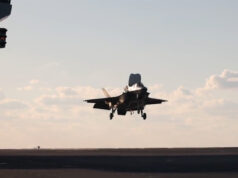The UK and Germany have announced a new collaboration to develop a long-range precision strike weapon with a range exceeding 2,000 km.
The announcement marks the first major milestone under the Trinity House Agreement, signed in October 2024, which established the first bilateral defence cooperation framework between the two nations.
According to the Ministry of Defence, the weapon will be among the most advanced systems designed by the UK, aimed at enhancing NATO’s deterrence capability while supporting national security. The project is also expected to bolster the UK and European defence industries, creating skilled jobs and driving economic growth.
The agreement was revealed during the first Trinity House Defence Ministerial Council, held today in Berlin, where German Defence Minister Boris Pistorius hosted UK Defence Secretary John Healey MP. Discussions focused on how the Trinity House Agreement is strengthening European security and boosting economic development through defence collaboration.
Healey stated: “The UK and Germany have never been closer, and the Trinity House Agreement is already making a positive impact on our security and economy. This partnership is helping us make defence an engine for growth – creating jobs, boosting skills, and driving investment across the UK and Germany.”
Additionally, the two nations discussed a joint procurement programme for Sting Ray torpedoes for P-8 Poseidon maritime patrol and reconnaissance aircraft. This initiative aims to enhance the UK and Germany’s ability to counter underwater threats. Germany will also procure advanced British military bridges as part of the collaboration, supporting jobs in the North-west of England.
The next meeting of the UK and German defence ministers will take place tomorrow (16th May) in Rome, alongside their Polish, Italian, and French counterparts, as part of the European Group of Five (E5) Defence Ministers meeting.














2000km range is fantastic, especially if deployable from a stealth platform.
Will the Germans agree to it being sold to anyone…….
With that sort of range I don’t think stealth would be even remotely necessary, you could launch from well outside of air-defences. What I wonder most is how this fits in with the Storm shadow replacement and the hypersonic weapons being developed. Perhaps it could be used to carry a nuclear warhead?
Think the real win would be if it could be sub launched
Ending the reliance on the US tomahawk for this capability
Presumably the stealth is more for the missile than the platform it is launched from, and so not wanting to be intercepted stealth is still a big factor/benefit for missiles.
It needs to penetrate those air defences though. It’s getting increasingly hard to do that without being very low radar return or being very high speed.
Yes, Yes, Yes – nuclear warhead might is the only thing Russia respects.
I don’t think you will find the UK wanting to market such a missile outside of direct allies to be honest
All indications are that it will be land launched not air launched.
That makes sense
Absolute crap – there are no indications whatsoever that this weapon will be land launched
2,000 km!
It does it it’s part of the ELSA programme that we joined. That was to develop a 2000km range ground launched cruise missile.
FCASW built between us, France and Italy will be the Storm shadow replacement for air launched weapons.
Yes there are
1) both Germany and the UK have already committed to purchasing air launched cruise missiles in numbers with new programes the UK and Germany both ordering lots of 600km+ air launched cruise missiles.
2) the UK is also developing the same air launched future cruise missiles to fit on its ships.
3) 2000km+ range cruise missiles are huge and run over 6 meters long and hit 3500Ibs
They are not launched from tactical fighters.. only strategic bombers.
Since the UK and Germany don’t have the aircraft that can lob a 6+meter cruise missile and they have already ordered/committed to their replacement cruise missiles for their strike aircraft and the uk has already committed to its ship launched system.. unless Germany and the UK are planning to buy a strategic bomber fleet these will be ground launch weapons.. that is why it’s a 2000km + range so the UK can directly hit mainland Russia from the UK….
Hi mate, sorry to be the bearer of bad news, but the 2000km range isn’t long enough to hit Russia from the UK. 2000km is approx 1250 miles. London to Moscow is approx 1800 miles, so we are somewhat short of legs to actually strike Russia from anywhere in the UK that might actually cause them any harm.
Agree we could target the Kaliningrad Oblast, but that’s about it I’m afraid. It is difficult to see whom we could actually Strike from the UK, thus why do we actually want/need it, unless we are basing these units in mainland Europe itself?
Checking out what Deep32 has said it would seem it’s going to be on some form of mobile transporter, so certainly will have considerable deterrence value. This seems to offer the sort of capability that China is developing that is scaring the US in terms of its carriers certainly in terms of range. And why it’s getting concerned about the range of its strike aircraft accordingly leading to both its new Naval strike fighter and the likes of Tempest gaining considerably in size. Concerning for F-35 operations as time passes.
@ deep, Murmansk is around 1800km from UK soil.. that would piss then off.
@deep st Petersburg is 2000km if we ever wanted to run their faces in tit of tat cultural destruction that would hurt.
Missile base Shetland to rain destruction down on Murmansk.
You could easily hit high priority targets in Kaliningrad Oblast from Tunbridge Wells though.
A 6m+ Cruise Missile might be a good fit for Tempest, depending on how big a Weapons Bay it ends up with.
@Paul T,
To get a 2000km missile with a large conventional warhead might well mean 7m long and nearly 2 tonnes. Even Tomahawk only achieves that sort of range by swapping the massive warhead for a smaller nuclear one and extra fuel.
It seems unlikely that such a large missile will fit inside Tempest, which has probably been designed around FC/ASW sized missiles. However, if the bay has been designed for 2 Meteor lengthways (ie truly enormous), then you might just be able to fit such a large weapon.
Hey spyinthesky…but 2000lm is long enough to hit Russia from the UK…just not London to Moscow. Launch from northern Scotland and naval bases around murmansk and army sites around st petersburgh are in range. Meanwhile….The Germans will he able to hit Moscow!
We don’t know many details but if MRSS specification does move towards configurable/containerised weapons packages then maybe that could be a launch platform. To get within 2,000km of Moscow (for instance) you don’t even need to go into the Baltic, staying in the North sea 100km or so off the west coast of Denmark gets you within 1,900km range of Moscow. Go round the northern tip of Denmark to station the ship offshore from Gothenburg or Copenhagen gets it within 1,600km of Moscow. All still very much in friendly relatively defensible territory for a launch platform and if it came to that I would hope that countries such as Denmark and Sweden would be part of the war effort and not have issues with missiles over-flying their territory and also be able to provide robust air defence for the launch platform.
If MRSS does evolve to a spec capable of hosting such a launch capability that might be a nice bit of joined up thinking.
There is the rub, Germany have already screwed the pooch on the Saudi Typhoon order, probably Turkey too.
I wouldn’t be developing any weapon systems with Germany, very unreliable partners who have cost us billions in eports..
The time has come for an entente Germanique! Germany has loads of cash due to the end of their debt-brake.
But they are still a bunch of peaceniks!
They will block any and all sales outside of NATO.
I would stick to the French for arms development, they will sign off an arms deal to absolutely anyone!
Need to see now the new Govt works out, with their intent on creating Europes biggest army et al and a relatively stagnant economy, I would think they might appreciate foreign sales moving forward. I certainly hope we have discussed matters.
We can hope, but I would be extremely wary of anything involving the Germans.
The range is very interesting because essentially a 2000km missile allows the UK to hold Russia at risk of attack directly from the UK. This is important because it would mean the UK could attack without needing an SSN in the high north as a strike platform or for typhoons to close within 400-500km of Russia.
It’s pretty much essential for the UK to be able to evidence that it can hurt Russia via long range strikes over and over again, as this requirement is a core deterrent against war.
Yes, I believe it’s why the range is set at 2000km, this will be land lunched from some form of moving vehicle and be able to be fired on mass from the UK or Germany into Russia.
It’s designed to provide a prompt massive precession strike as an alternative to tactical nuclear weapons to act as a deterrent to Russia.
Complete rubbish – you can’t even spell “precision” –
What’s the ability to spell got to do with anything
Well I guess Dave is one up from the mindless fake ads, but barely. 😈
No it’s the correct analysis for the information available and the geostrategic picture.
Do we think this is a cruise missile with terrain following and another version of tomahawk ? Slow and low? or ballistic? Knowing our preference with FW/CAS with the French we wanted something subsonic and longer distance but the French wanted hypersonic
This will be sub sonic long range and stealthy. it will borrow heavily on the technology for FC/ASW as MBDA will be building it. It’s likely to be a longer range land based version of the sub sonic FC/ASW as the French are often discussed in its development as well.
Bollox – there is no information about stealth or speed, no mention of FC/ASW whatsoever and no mention of French involvement at all
Savid, this looks like trolling. You can make your important points another way.
David! I can spell but typing isn’t mu forte! Apologies.
Hi Jim, are we looking at this as the next chapter, after FC/ASW, do you know? Given we have Tomahawk now on SSNs it would make sense to have a subsea launched version, can you imagine the reach associated with that option? Almost no corner of the globe unreachable. I’d like to see this solution as land-based, as you say, with a design and/or conversion kit so it could be used as air-launched at some point and ….. crucially, integrated onto an F-35 (better start talking to LM now then!).
I’m more interested in potential maritime use of this be it submarine or even surface launched. I wonder if an AUKUS version might be an option for those vertical tubes.
It’s almost undoubtedly not going to be a ballistic missile as that would essentially be scratch developed of an IRMB, essentially a multi stage sub orbital booster and re-entry vehicle, not something the UK or Germany has a lot of experience and it would be a profoundly expensive and limited numbers platform.. I suspect a stealthy cruise missile as both Germany and the UK have experience with that.
I would bet my bottom dollar this is a ground launched system as Germany has already ordered 600 Taurus Neo as airlaunched cruise missiles and the UK is working on an airlaunched and ship launched system with France.
The Western European nations seen to be very much gearing up on their ability to deliver pain.
Agree. From when I first read of this last year it seemed clear this is a ground launched system. So you’d assume in the hands of the Royal Artillery.
Agreed and one reason we have forward deployed land forces I would have thought.
The long range subsonic missile developed with France as one half of FCASW has an IOC date of 2027. This new missile, mentioned in the original 2024 TH agreement, is presumably an entirely separate project. We also have project Brakestop about to achieve first flight. I presume that this new missile will be ground launched and ballistic. If not, isnt it just duplicating weapons already in development?.
Hi Peter the range is the difference, a 2000km + missile is a direct threat to Russia, without UK forces having to go anywhere near Russia.
I hope this does not affect the existing Deep Fires, PRSM, GMLRS program, that is ready and needs money and assets now?
I can see CND types ( not nuclear I know ) following these around like back in the day with GLCM, if they need to disperse.
I w would hope not after all it’s a different capacity.. after all a ground based 2000km range cruise missile capability is essentially a conventional strategic asset/deterrent, not a tactical one like deep fires.
Yes. I’m not opposed at all it would be an important capability. I’m just wary of assets needed now with funding taken for paper Tigers tomorrow.
And tomorrow often is cancelled.
The MIC of course don’t repay the cash spent.
Yep fingers crossed the position of the geopolitical picture means the stuff that can be done know will get done and not cut for jam tomorrow.
Gunbuster did comment before that the Tax etc that BAE Systems pays to the Uk treasury is equivalent to a 2p rise in income tax . UK 25 % of sales at the moment
Hi Daniele,
Yeh, there is a risk that they try to rely on ‘wonder weapons’ and avoid paying for the mass that we so desperately across the board…
On the positive side Europe does seem to be stepping up at least on the complex weapons front where we traditionally relied on the US to provide the capability.
We will see.
Cheers CR
And that my dear fella is the million £ question is it not. What are we going to give up for a system that can actually only Strike at the Kaliningrad Oblast from the UK.
Despite all, the excitement on here, 2000 km (1250 miles) isn’t far enough to hit anywhere in Russia from the UK. London to the Russian border is approx 1550 miles – approx 2450 km!!
Wwe are not going to be basing these in Germany, why would we if they’ve got some. So, all in all why do we need them and who are we actually going to target from within the UK?
Hi mate.
If they are deployed with the Field Army why could they not go to Eastern Europe with other NATO assets?
Absolutely agree that they could mate, but with everything else we’re supposed to be getting and with at least Germany having them, why do we need them? This isn’t going to be cheap, my question would be’ do we actually need them’ given that they would need to travel to get into shooting range.
I think that this would be money better spent elsewhere within the armed forces aswell got lots of capability gaps across the board that need filling surely.
I’m inclined to agree mate.
Is this a weapon that the military actually wants, or a political construct so ministers can look good that we are in with our European allies?
As I said above, I’m not against it as such, of it holds Russia at risk, but there are programs in place now that need funding, PRSM for example.
I hope they don’t wither and die when we throw billions at more jam in a decades time in this.
You just know HMG will prefer grandstanding with this rather than resource the military now. .
I understand your concerns but surely we have very few weapons that can hit Russia from the UK. We have tanks but so do the Germans and others so by your logic why have tanks when most here say we need more. Typhoons and F-35s would be pretty ineffective attacking Russia from the UK and again the Germans and others have them so why would we need them, I mean the list is endless surely only the nuclear deterrent doesn’t fall under this category in the end. Why would you want to simply rely on the Germans being able to do long range strike of this nature on their own, bad enough having the US with many capabilities we don’t because we assumed they would always be there to use them, an assumption we are slowly coming into doubt of late. Can’t just rely on other Countries to do things for us and if long range weapons aren’t long enough where does that leave shorter range ones then, how does similar logic not apply, not to mention the Germans might not be operating these close to where the UK forces are operating, like Norway or Finland perhaps.
Hi Spy.
The army is still waiting on funding for the last 15 M270 conversions to complete the expansion of our Deep Fires capability.
I dont want all that, the first good news for the RA in a long, long time, hijacked by things like this.
If moneys no object for both, fine, all is well.
We know money isn’t no object though. So what gives? This worries me.
Morning Spy,
Agree, we do need to stand on our own two feet and increase said monies on defence. The stark reality at present is that amy increases are going to be modest despite what we all believe we need. We have capability gaps across the board, the latest I believe is that FT Vic has a OOS date of 2028, with FSSS not being available until 2033/4. Absolutely unbelievable!!
We haven’t finished with remodernising the RA yet, we are due some 155mm howitzer (RCH 155?), Prsm and LPS to name but some. Let’s finish this before we start on another wish list.
We already have capabilities that can Strike Murmansk and the Kaliningrad Oblast, and I’m not referring to Tridant. We are not a mini America so I would argue that we dont need to try and act like it and that this is a capability we don’t really require.
It can hit the st Petersburg area as well as Murmansk. According to my as the crows fly app uk soil to Murmansk is 1800km and st Petersburg is 2000km
Not sure why hitting Kaliningrad or the Estonian Border Regions like Pskov and Narva would be a bad thing, given that those would be the very first areas of high priority targets…
I’m sure that they are priority targets, but, the area is surrounded by NATO countries, our BG in Estonia is within striking range with M270s. Why do we need what would arguably be a v expensive system to shoot from the UK into areas already within easy NATO assets reach?
Same applies to striking Murmansk as some seem to think, Norway and Finland are far better positioned to deal with that, then the UK spending millions on a system to lob a few missiles into Murmansk. We have more important capability gaps to fill before chasing this dream.
It actually says something about the potential future geopolitics. Because the main reason for this weapon would be an instant response to an attack on the UK without any need for immediate NATO support.
Therefore from a UK point of view it provides a direct deterrent that is agnostic of a NATO response.
Maybe HMG is starting to get a bit worried that Russia may gamble that a limited missile attack on the UK would not enact an immediate NATO response…
Or even more concerning is maybe HMG is becoming worried that it needs to have options that don’t include full nato support.
Nuclear capable? if not it should be
It won’t be as to not spook the Russians, this is designed to provide an alternative to tactical nuclear weapons for countries like Germany so they can have large scale precision strike.
If we put nuclear weapons on it we risk a return to the 80’s and the potential hare trigger response that nuclear TLAM brought in.
Why do you make up this sort of crap? There is no mention of nuclear weapons in the statement.
Hi David I know you’re a bit thick pal so let me explain.
Some of us read more than one source for information.
Google is your friend grandad 😀
Lots has been written on this weapon since the trinity house agreement, I suggest you do a bit of reading.
Write back if you want me to explain it for you.
👍
I wondered how long you would keep your peace. 🫣
He’s not a rejected lover is he Jim, he certainly seems besotted with you poor love.
Never thought of that 😂
Hence, not a nuclear weapon, you are agreeing with Jim.
Would probably be nice for him (and indeed for the rest of us) if you occasionally passed by one of his comments without taking the opportunity to insult him.
Totally agree
David Lloyd – Please stop being insulting and nasty to Jim
Are you OK?
He’s a bot it’s just a matter as to whether he is a sub human or cyber bot. either way the programming is glitching and obsessed with Jim.
Hi Spy.
David is very much human. He’s one of our ukdj posters i know beyond our forum.
As for his issues with Jim, that’s his affair.
Why don’t you just try being more civil? there’s plenty of other internet forums where you can be rude and obnoxious. You seriously lower the tone of this place.
On the contrary, he’s rude and obnoxious on other forums as well.
It’s his whole intent, just trying to cause disruption not actually contribute anything.
As soon a nukes are used everybody & everything loses. What we need is the ability to hit vital targets conventinally to knock out Russias war fighting capabilities & make them think they can’t win.
just a stand off nuke, something like the ASMP-A
Another interesting thought for a 2000km ground launched cruise missile is if you place a battery in Akrotiri, you can strike straight into Iran with Tehran only being 1600km distance.. so it would potentially act as a deterrent to that enemy as well.
So is this just a means of avoiding using Storm Shadow and Voyager trails for long range strikes?
I can see issues with this missile trying to be low cost so that it can actually be used in the middle east, while simultaneously having exquisite stealth, ECM etc. so that it is a credible deterrent in Europe.
I’m not saying they would use it in the Middle East, but have it as a deterrent to Iran it would be credible and to be honest if your holding Iran at risk ( via a credible threat to Tehran) as a deterrent you want a decent missile as its air defence systems are going to be reasonable.. obviously if your undertaking actions against terrorists or other more standard Middle Eastern threats then your dropping a paveway.
Look at Russia it’s not flinging IRMBs in droves at Ukraine, it used it once to let the west know it had them pointed in our direction.. successfully strategic ( nuclear and conventional ) are at their best when never used.
Agreed, I think long range conventional strike could be a very useful capability to simply hold the enemy perpetually at risk.
We’re looking at something maybe even slightly larger than Tomahawk (1.5x range, probably similar warhead), most likely to be stealthy, turbofan powered.
Primarily ground launch, but I think external launch from Tempest would be a really interesting option later on.
2000km radius from Tempest plus 2000km missile range means there wouldn’t be many places on Earth inaccessible from UK bases.
Co-incidentally 1600km is also the distance as the crow flies from Berlin to Moscow. We are developing this missile jointly with the Germans.
More and more I think the defence review is going to be very interesting.. capability to do harm seems to be big on the agenda.
And how many will we actually purchase after a multi billion pound development. 10-20 missiles.
In all seriousness if we are getting hundreds and hundreds then great. If as is usual we end up with a penny pockets minimal force level then I’d rather the MOD purchased in more armaments that are already in production.
I think this is a political gesture as part of the Brexit reset and trying to support more indigenous production capacity within Europe since the Orange Messiah came into POAC and the USA clearly having a retrenching philosophy to the rest of the world.
I would imagine it will be a good amount. In the end cruise missiles are generally purchased in larger numbers.. I would bet at least 100 for each nation.. and these are going to be big missiles so it will take a while to build them.. I would imagine that they will plan to keep the production line hot as part of the deterrent is not just having a number of missiles but also being able to keep building them during any conflict and quickly ramp up production.. the nation that builds more wins.
The last time the UK went cruise missile shopping we bought 900.
This weapon is being procured to act as a deterrent to Russia. If we can’t launch at-least a couple of hundred then it’s pointless.
The last time the UK went cruise missile shopping it went for around 1000 in total.. so I suspect that will be the total stock of the new generation, but what the mix is between future cruise and this missile its anyone’s guess… as a shot in the dark I will go for 80/20 so 800 future cruise for the RN and airforce and then 200 of these long range land based missiles.
The obvious reason to be developing very long range strike capabilities- specific scenarios aside- is in order to counter the steady advance of adversary A2/AD capabilities.
I would suggest it’s probably a deterrent for Russian long range systems to be honest. You fire an IRBM at the UK you get a whole bad of these back at you.
oooooo this will be great to have in our Arsenal
Good. We’re technologically decades ahead of the Russians nowadays but haven’t made it count because for a long time Whitehall hasn’t take the prospect of peer war seriously.
As usual the spin The project is also expected to bolster the UK and European defence industries, creating skilled jobs and driving economic growth.
I really wish for once someone would make a song and dance about how effectively a project will blow an enemy to kingdom come instead of looking no further than the frigging economy.
They prioritise their fat cat friends in industry. I keep saying it.
That is their main focus on MoD budget.
Not value or numbers, which are the areas we struggle in.
Hi New Me,
To be fair if you want to win a war of national survival, which is what we are talking about when we talk about Russia, supported byt rest of the CRINK nations, you need a strong economy capable of building and supporting the kit you need to fight as well as providing the treasure you need to pay for the hostilities only service people who will be needed to fight the war. If the economy is broke your chances of winning are seriously compromised. Churchill was aware of this during WW2, it is why we went along with Lender Lease.
Although, also in the spirit of fairness the government is rather pushing the point, but they kinda need to given that most people are still feeling worse off.
Cheers CR
Can it be fitted with a nuke? If so it could provide a tactical nuke strike capability for the UK and possibly be a delivery system for a shared European nuke defence.
Seems that someone has been watching the Ukrainians’ inventions and strikes deep into russia 🤣
“Well, why didn’t we think of that?”
“Wait, why don’t we build those?”
It will be interesting to see how this progresses!
It’s great to be able to throw things over the fence from 2000km away but there surely there needs to be more action as to what’s happening with UK-Europe GBAD to defend against very similar things being thrown back over our fences? It can’t just be mostly all ship based when they may be needed elsewhere. And obviously there’s a need to protect the launch bases themselves.
Someone realised that airbases and aircraft are at grave risk and there is need of attack alternatives.
Plus the increasing costs and delays of ultra complex aircrafts projects will boost much more the missile solution.
Iran and Houthis can do a lot without an Air Force.
We should never have cancelled Blue Steel.
How about a few more P-8s to go with the Stingrays?
Has anything been mentioned if this is seperate to ELSA or is a revised version of ELSA?
Well, Germans, can buy aero ballistic hypersonic missiles from Israel, immediately… “Golden Horizon”, up to-2000 km. “5M”+, PD – up to 4 m. (EO) etc. etc, or transfer a license, Israel will not refuse. PS. Two additional 650 mm.TA to Type 212CD and Popeye Turbo 2.0 – 2000 km… Regards and have good weekends!
Reply
I cannot understand why we’re arguing about the effectiveness of hitting Russia from the UK. This will be forward deployed like the rest of our forces during a war. The range is important because it means we can hit deep into Russia’s territory whilst supporting our allies on its border. We could then hit all of Russia’s European territory and 80% of its population from Ukraine, Finland or the Baltics. Russia would then be forced to move factories and bases to Siberia creating long logistical lines that would slow and easy to strike/sabotage.